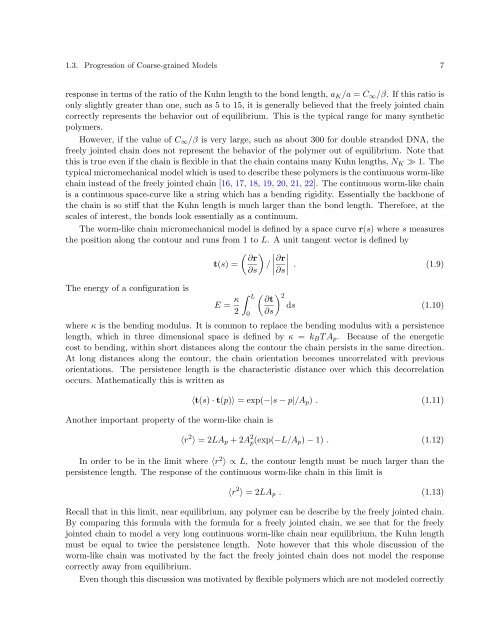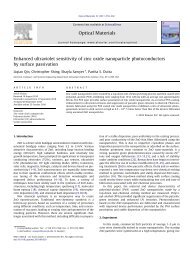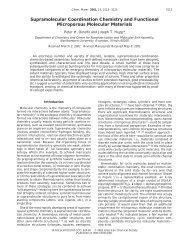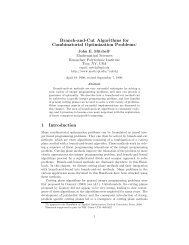Systematic development of coarse-grained polymer models Patrick ...
Systematic development of coarse-grained polymer models Patrick ...
Systematic development of coarse-grained polymer models Patrick ...
You also want an ePaper? Increase the reach of your titles
YUMPU automatically turns print PDFs into web optimized ePapers that Google loves.
1.3. Progression <strong>of</strong> Coarse-<strong>grained</strong> Models 7<br />
response in terms <strong>of</strong> the ratio <strong>of</strong> the Kuhn length to the bond length, aK/a = C∞/β. If this ratio is<br />
only slightly greater than one, such as 5 to 15, it is generally believed that the freely jointed chain<br />
correctly represents the behavior out <strong>of</strong> equilibrium. This is the typical range for many synthetic<br />
<strong>polymer</strong>s.<br />
However, if the value <strong>of</strong> C∞/β is very large, such as about 300 for double stranded DNA, the<br />
freely jointed chain does not represent the behavior <strong>of</strong> the <strong>polymer</strong> out <strong>of</strong> equilibrium. Note that<br />
this is true even if the chain is flexible in that the chain contains many Kuhn lengths, NK ≫ 1. The<br />
typical micromechanical model which is used to describe these <strong>polymer</strong>s is the continuous worm-like<br />
chain instead <strong>of</strong> the freely jointed chain [16, 17, 18, 19, 20, 21, 22]. The continuous worm-like chain<br />
is a continuous space-curve like a string which has a bending rigidity. Essentially the backbone <strong>of</strong><br />
the chain is so stiff that the Kuhn length is much larger than the bond length. Therefore, at the<br />
scales <strong>of</strong> interest, the bonds look essentially as a continuum.<br />
The worm-like chain micromechanical model is defined by a space curve r(s) where s measures<br />
the position along the contour and runs from 1 to L. A unit tangent vector is defined by<br />
<br />
∂r <br />
t(s) = / <br />
∂r <br />
<br />
∂s ∂s<br />
. (1.9)<br />
The energy <strong>of</strong> a configuration is<br />
E = κ<br />
2<br />
L<br />
0<br />
2 ∂t<br />
ds (1.10)<br />
∂s<br />
where κ is the bending modulus. It is common to replace the bending modulus with a persistence<br />
length, which in three dimensional space is defined by κ = kBTAp. Because <strong>of</strong> the energetic<br />
cost to bending, within short distances along the contour the chain persists in the same direction.<br />
At long distances along the contour, the chain orientation becomes uncorrelated with previous<br />
orientations. The persistence length is the characteristic distance over which this decorrelation<br />
occurs. Mathematically this is written as<br />
Another important property <strong>of</strong> the worm-like chain is<br />
〈t(s) · t(p)〉 = exp(−|s − p|/Ap) . (1.11)<br />
〈r 2 〉 =2LAp +2A 2 p(exp(−L/Ap) − 1) . (1.12)<br />
In order to be in the limit where 〈r 2 〉∝L, the contour length must be much larger than the<br />
persistence length. The response <strong>of</strong> the continuous worm-like chain in this limit is<br />
〈r 2 〉 =2LAp . (1.13)<br />
Recall that in this limit, near equilibrium, any <strong>polymer</strong> can be describe by the freely jointed chain.<br />
By comparing this formula with the formula for a freely jointed chain, we see that for the freely<br />
jointed chain to model a very long continuous worm-like chain near equilibrium, the Kuhn length<br />
must be equal to twice the persistence length. Note however that this whole discussion <strong>of</strong> the<br />
worm-like chain was motivated by the fact the freely jointed chain does not model the response<br />
correctly away from equilibrium.<br />
Even though this discussion was motivated by flexible <strong>polymer</strong>s which are not modeled correctly







